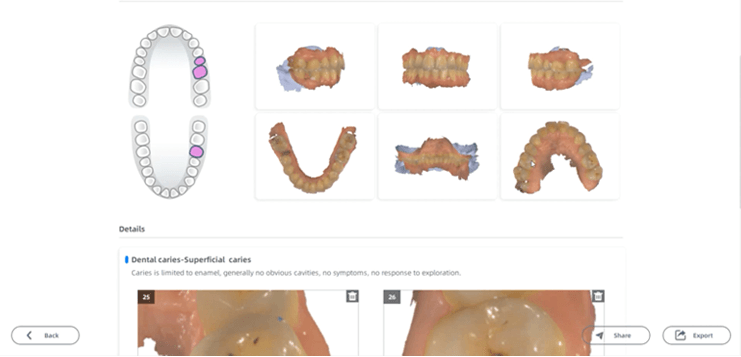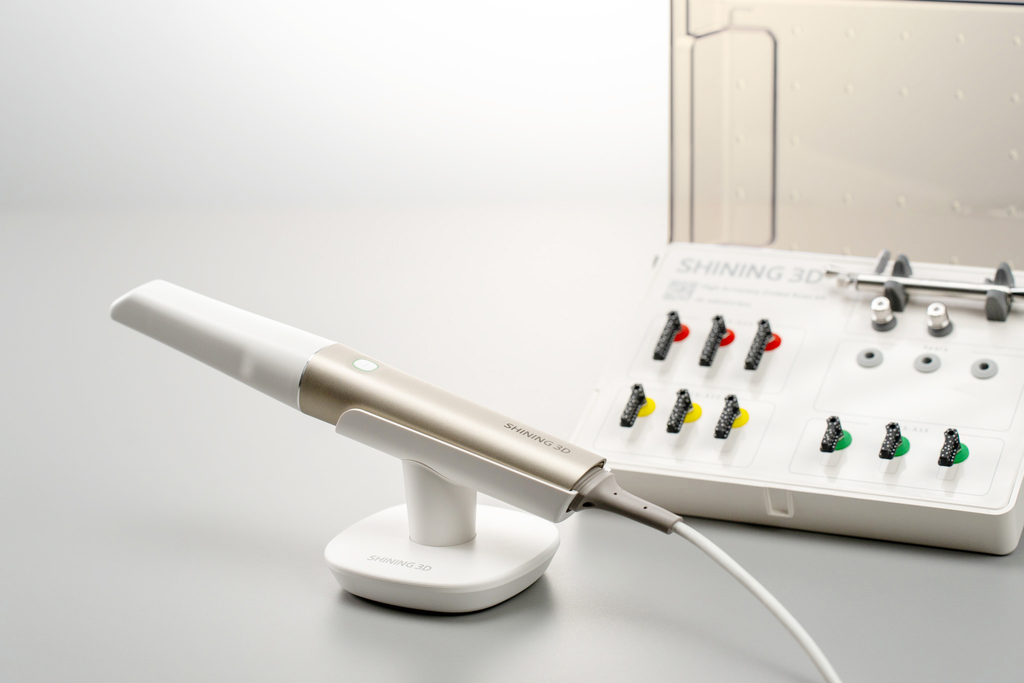Table of Contents
In the intraoral scanner market, significant price differences and numerous brands reflect a substantial gap in core technology, scanning accuracy, operational smoothness, ecosystem, etc. These differences directly impact clinic efficiency and patient comfort.
A scanner with poor user experiences may not only fail to integrate into the workflow and end up stored in a cabinet, but also lead to a waste of the clinic’s valuable funds and resources, as even a common scanner can cost tens of thousands of dollars.
So, what are the differences between expensive and affordable intraoral scanners? What matters for your clinic when evaluating intraoral scanner prices? Continue reading to learn more.

Expensive vs Affordable Intraoral Scanner: Tech Differences
The first step in evaluating different intraoral scanners goes beyond just the hardware itself. Technology is a key factor driving intraoral scanner price differences, as it directly impacts the most critical aspects of scanning: image, accuracy, and speed.
1. Image Quality
Image quality refers to whether the image edges are sharp and clear, with rich details, and effective automatic removal of soft tissue artifacts (cheeks, tongue, etc.). Even in saliva- and blood-rich oral environments, it should deliver high contrast and true color reproduction.
This is one clear difference between expensive and affordable intraoral scanners. By comparing several models, it’s easy to find that some budget options produce darker images with less defined edges and slightly inferior detail compared to high-end models.

2. Scanning Precision
The difference in scanning precision lies in the technologies of various intraoral scanners. Most scanners on the market employ structured light technology (utilizes reflected light). However, reflected light is easily affected by ambient lighting and the surface moisture of the scanned object.
Other scanners utilize advanced photogrammetry technology, including extraoral and intraoral photogrammetry. These systems work by analyzing photographic images and electromagnetic radiation patterns to obtain oral models, resulting in higher accuracy and intraoral scanner prices. For example, SHINING 3D Aoralscan Elite Wireless is an intraoral photogrammetry scanner that uses encoded points on coded scanbodies to capture the position of the gum/implant, effectively controlling errors within 5μm.
Furthermore, the distinction between expensive and affordable intraoral scanners also manifests in how your operation affects precision. After all, unlike robots, human operators cannot maintain a perfectly uniform scanning motion every time. For instance, some intraoral scanners require strict scanning distances and specific hovering times, making it difficult to achieve their theoretical accuracy in a busy clinical setting.
3. Scanning Speed
When your clinic plans to move to intraoral scanning, the goal is undoubtedly to achieve higher efficiency, eliminating the wait for impression material to set and avoiding the risk of impression failures.
High-end scanners allow smooth movement over tooth surfaces, instantly generating clear 3D models on the screen with almost no delay. This is crucial. It shortens the patient’s mouth-opening time and effectively reduces motion artifacts caused by patient movements (such as tongue shifts or swallowing).
If scanning speed is overlooked during considering intraoral scanner prices, slower imaging may require the dentists to move the scanner more slowly and steadily, pausing in certain areas to wait for data capture. To obtain complete data, multiple additional scans might be necessary. This somewhat cumbersome operation may discourage you from using it.
4. Anti-Interference
It refers to the ability to capture the true morphology of oral structure even in the presence of saliva and bleeding, without being affected by obstructions from the tongue and cheeks. Extraoral and intraoral photogrammetry scanners excel in this regard. This advantage stems from their working principle, which avoids the susceptibility to reflected light instability seen in structured light-based scanners.
3D oral scanners with strong anti-interference capabilities decrease error risks in clinical operations. Dentists can avoid the need for repeated impressions, and patients are spared multiple visits to the clinic.

Expensive vs Affordable Intraoral Scanner: Experiences
After trying several different 3D oral scanners, you’ll realize that experience is a key factor besides technology that influences intraoral scanner prices how frequently you use the device. It can be quite frustrating to purchase an intraoral scanner only to find it difficult to operate. It includes:
1. Ease of Use
- 🔺 Ergonomics: High-end scanners typically feature well-designed scan tips, are more compact, lighter, and better balanced. The handles offer a comfortable grip, reducing fatigue during prolonged use.
- 🔺 Wired vs. Wireless: Wireless models of the same scanner type tend to be slightly more expensive than their wired counterparts, as wireless operation provides unparalleled flexibility, avoiding cable tangling or tugging.
- 🔺 Need for Powder: When scanning prepared teeth for most restorations (such as ceramic crowns or veneers), affordable scanners often require uniform and sufficient application of powder to capture data. In contrast, high-end scanners eliminate this step, sparing patients the discomfort associated with powder.
- 🔺 After-Sales Service and Training: High-end scanners typically include comprehensive, professional training services and longer warranty periods. The manufacturer’s responsiveness to issues significantly impacts long-term user experience.
2. Open vs Closed System
Scanners with open systems generate data in standard formats (such as STL, PLY, and OBJ files), which can be freely shared with any third-party organizations that support these formats, such as dental labs or orthodontic software platforms. STL files are monochrome, while OBJ and PLY files support color. All digital dental scanners can export STL files, but not all support PLY or OBJ formats.
If the software and hardware of your equipment are developed by the same company, closed systems typically offer highly integrated, stable, and seamless performance. However, this is often not the case in practice. Therefore, opting for a digital dental scanner with an open system is recommended, as it integrates more easily into your clinic’s existing workflow.
How to Choose the Best Intraoral Scanner?
In summary, expensive and affordable scanners differ in areas such as image quality, accuracy, ease of use, etc. So, how do you choose the best intraoral scanner while considering the intraoral scanner price? We recommend making a selection based on application scenarios, patient flow, and budget.
- 🔺 What is your main focus? Does your clinic specialize in common restorations (crowns, bridges), or in orthodontics or complex procedures like All-on-X implants? While simple restorations can be handled by an affordable model, complex surgeries such as All-on-X implants require the high precision offered by advanced intraoral photogrammetry scanners.
- 🔺 High patient flow clinics need scanners with fast scanning speeds and efficient data processing capabilities. If daily workflow pressure is moderate, an affordable scanner may be more cost-effective.
- 🔺 Ultimately, the choice of an intraoral scanner depends on your budget. High-end models are generally the recommended option, both for immediate use and long-term clinic upgrades.

In the intraoral scanner market, SHINING 3D DENTAL is a globally recognized brand. We offer the affordable Aoralscan 3 and Aoralscan 3 Wireless, which utilize structured light technology, as well as the high-end SHINING 3D Aoralscan Elite and Aoralscan Elite Wireless models that integrate both structured light and intraoral photogrammetry. The Elite series delivers precision up to 5μm, meeting the high-accuracy demands of complex procedures such as All-on-X implants.
Why Choose Us?
SHINING 3D DENTAL leverages two decades of expertise in industrial metrology. We independently developed VPG (Video Photogrammetry) technology. By deeply integrating multi-camera arrays with intelligent algorithms, we were among the first to incorporate precision photogrammetry tech into industrial 3D scanning equipment.
When industrial-grade photogrammetry technology is applied to dental diagnostics, our intraoral photogrammetry solution addresses universal challenges in global dentistry, such as soft tissue deformation and optical interference in edentulous implant cases, enabling precise calculation of implant positioning.
Want to invest in intraoral scanners? Feel free to contact us for a detailed intraoral scanner price and product consultation!
 ENG
ENG








